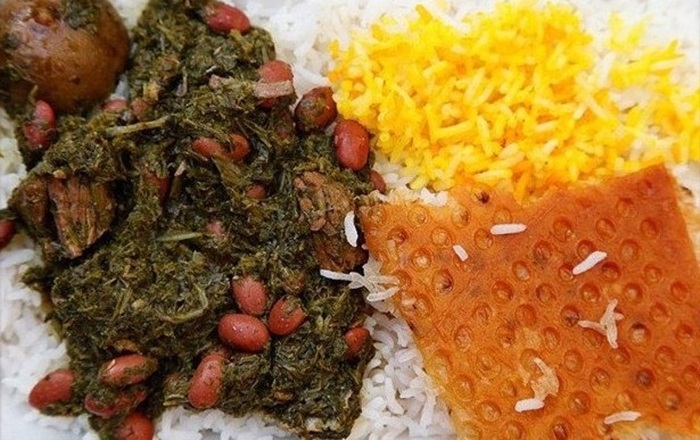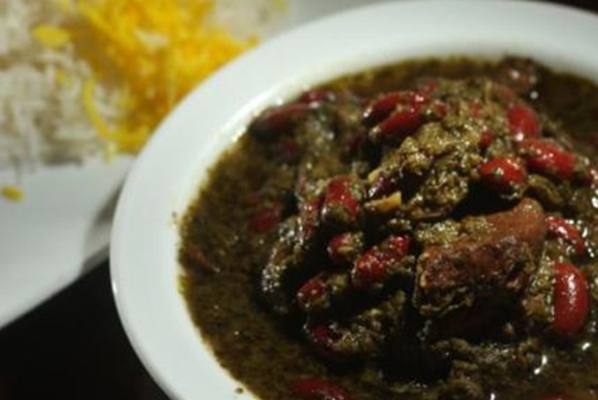Iranian dishes excel at making people who have never tried them fall in love at the first bite. The unique combination of spices and flavorings with a wide range of vegetables, herbs, fruit, grains, nuts, meat and most importantly rice only needs the wand of Iranian cuisine to perform magic and leave an explosion of unforgettable tastes in the mouth. Their delectable smell, delicious look and perfectly pleasant taste make it almost impossible to resist them. To share the gastronomic delights of Iran, IFP has decided to file a series of recipes for mouth-watering Iranian dishes.
Ingredients:
Serves 4-6
1. 750 grams – 1 kg cubed boneless lamb leg/beef
2. One cup red beans (100 grams) – It is advised that you soak them at least for half an hour.
3. 500 grams finely chopped parsley
4. 250 grams finely chopped wild leek
5. 100 grams finely chopped coriander
6. 100 grams finely chopped spinach
7. 50 grams finely chopped fenugreek
It is worth noting that there are no hard-and-fast instructions about the amount of herbs used in this dish. For instance, some prefer to go heavy on wild leak and use less parsley, so the amount of each herb used depends on your taste. More wild leek will add a sharp taste to the stew. Too much fenugreek will turn it bitter. Spinach plays the role of a thickener and won’t let the final stew be too watery. The amount of coriander should not outweigh other herbs. All herbs have to be finely chopped; otherwise the stew won’t look and taste nice at the end.
8. One-two large onions which are peeled and finely chopped
9. Three-four dried limes – they give the stew a special flavor. Try to buy them from Iranian grocery stores. Some recommend replacing them with other flavorings, but if you do, a special unique taste will be missing. They should be soaked in water for a few minutes and pierced with a fork. Avoid overusing limes, because they will give a bitter taste to your stew.
10. Verjuice [a highly acidic juice made by pressing unripe grapes] to taste
11. Salt, ground black pepper and turmeric to taste
12. Oil
13. Water
Directions:
Bags of frozen fried herbs to be used for this stew are a fixture of almost every Iranian housewife’s freezer because they can save time in cooking this all but time-consuming dish.
1. Fry all finely chopped herbs with a liberal amount of oil until they take on a nice dark color.
2. Fry onions with oil over a medium heat in a separate pot until they turn soft and golden brown, add turmeric and pepper to it. Salt can be added toward the end of cooking to stop meat from toughening and prolonging the cooking time.
3. Add the red beans to fried onions and sauté them for a few minutes. [In case you want to use canned beans, you should add them in the last 30 minutes.]
4. Add the meat cubes and sear them. [Some prefer the meat cubes in this dish to be large, if you don’t like it that way, you can cut them into small ones].
5. Now, add the fried herbs and fry them with other ingredients for a second time.
6. Add a liberal amount of water to the pot and bring it to the boil, then turn down the heat, keep the lid on the pot and and allow it to simmer gently for 2-3 hours [until the meat and beans are tender and well cooked]. Avoid adding too much water because you will later have difficulty getting rid of it when the ingredients are thoroughly cooked. At the end, your stew must not be watery or thin.
7. In the last one hour, pierced dried limes can be added. At the end, they should be fully soaked and soft. However, they should not have fallen apart.
8. Toward the end of the cooking you can add salt and verjuice to taste.
The stew, which should look thick and a bit oily at the end, is served with rice.
Bon Appétit!

